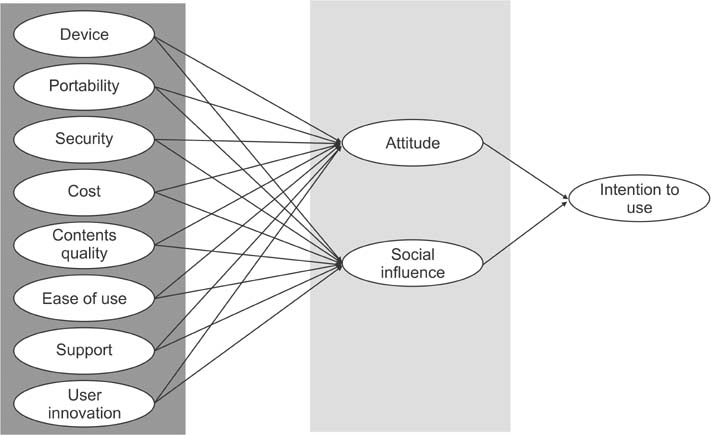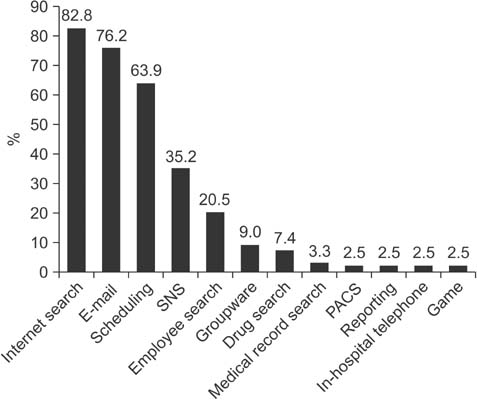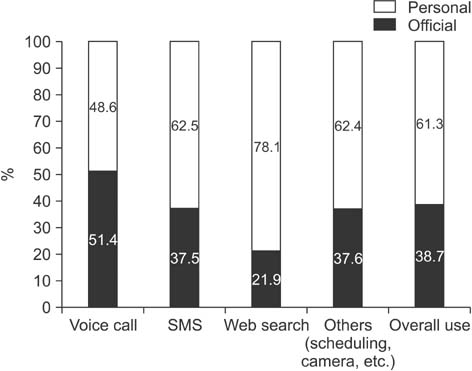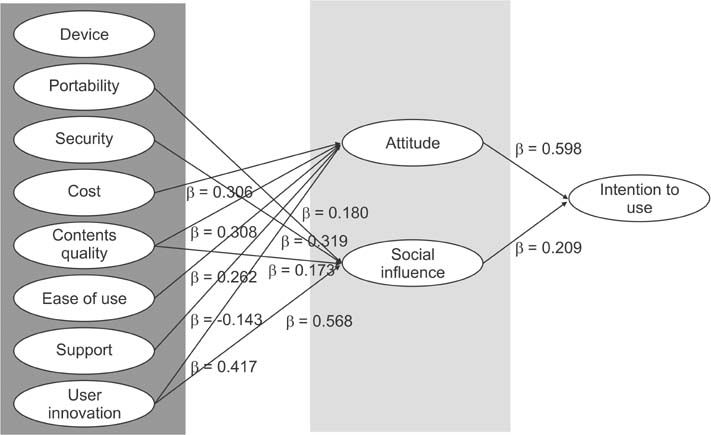Healthc Inform Res.
2014 Oct;20(4):304-312. 10.4258/hir.2014.20.4.304.
Technology Acceptance and Adoption of Innovative Smartphone Uses among Hospital Employees
- Affiliations
-
- 1Department of Health Services Management, Graduate School, Kyung Hee University, Seoul, Korea.
- 2School of Management, Kyung Hee University, Seoul, Korea. hjchang@khu.ac.kr
- KMID: 2166806
- DOI: http://doi.org/10.4258/hir.2014.20.4.304
Abstract
OBJECTIVES
The number of healthcare institutions adopting smartphones continues to increase, implying that their utilization is undoubtedly gaining attention. Understanding the needs of smartphone users will provide a greater opportunity for successful information technology acceptance by expanding the scope of its utilization. This study focuses on how smartphones are accepted and utilized in hospitals and analyzes the factors influencing users' attitude, social influence, and intention of use.
METHODS
For the study model, the researcher has mainly adopted the Theory of Reasoned Action and further modified and used the models of Technology Acceptance and Information Systems Success. To test the model empirically, a survey was conducted with 122 professionals on information development teams in Korean tertiary hospitals.
RESULTS
The common smartphone usage modes were Internet searching, e-mail, scheduling, and social networking in consecutive order. Phone calls consisted of 51.4% of work-related purposes, while other functions, such as text message, Web browser, and scheduling, were mostly used for personal purposes. Costs, contents quality, innovation, ease of use, and support were shown to have statistically significant effects on user attitude, and social influence, portability, security, content quality, and innovation were significant. User attitude and social influence were both statistically significant with respect to intention of use, with user attitude greater than social influence.
CONCLUSIONS
The participating staff were analyzed as having strong personal faith and principles, independent from their external environment. Timely information exchanges among medical staff will facilitate appropriate communication and improved health services to patients in need.
Keyword
MeSH Terms
Figure
Cited by 2 articles
-
Medical Representatives' Intention to Use Information Technology in Pharmaceutical Marketing
Eun-Seon Kwak, Hyejung Chang
Healthc Inform Res. 2016;22(4):342-350. doi: 10.4258/hir.2016.22.4.342.Medical Representatives’ User Acceptance of Remote e-Detailing Technology: A Moderated Mediation Analysis of Technology Acceptance Model
Hyun Woo Kim, Hyejung Chang
Healthc Inform Res. 2022;28(1):68-76. doi: 10.4258/hir.2022.28.1.68.
Reference
-
1. Lee Y, Chang H. Ubiquitous health in Korea: progress, barriers, and prospects. Healthc Inform Res. 2012; 18(4):242–251.
Article2. Bae JK, Jeong HM. An empirical study on the determinants factors by including functional attributes of smart phone adoption. e-Business Stud. 2008; 9(4):337–361.
Article3. Ministry of Public Administration and Security. 2011 National informatization white paper. Seoul, Korea: Ministry of Public Administration and Security;2011.4. Boulos MN, Wheeler S, Tavares C, Jones R. How smartphones are changing the face of mobile and participatory healthcare: an overview, with example from eCAALYX. Biomed Eng Online. 2011; 10:24.
Article5. Gartner. Gartner top end-user predicts 2011: Gartner's top predictions for IT organizations and users, 2011 and beyond: it's growing transparency [Internet]. Stamford (CT): Gartner;c2010. cited at 2014 Oct 1. Available from: http://www.brittenford.com/documents/products/Gartner%20Predicts2011_IT_Transparency.pdf.6. Putzer GJ, Park Y. The effects of innovation factors on smartphone adoption among nurses in community hospitals. Perspect Health Inf Manag. 2010; 7:1b.7. Nolan T. A smarter way to practise. BMJ. 2011; 342:d1124.
Article8. Putzer GJ, Park Y. Are physicians likely to adopt emerging mobile technologies? Attitudes and innovation factors affecting smartphone use in the Southeastern United States. Perspect Health Inf Manag. 2012; 9:1b.9. Sheth N, Kane YI. Smart-phone makers call the doctor [Internet]. New York (NY): Wall Street Journal;2009. cited at 2014 Oct 1. Available from: http://online.wsj.com/news/articles/SB125487806705169673?mod=_newsreel_4.10. Yeo K, Lee K, Kim JM, Kim TH, Choi YH, Jeong WJ, et al. Pitfalls and Security Measures for the Mobile EMR System in Medical Facilities. Healthc Inform Res. 2012; 18(2):125–135.
Article11. Fishbein M, Ajzen I. Belief, attitude, intention and behavior: an introduction to theory and research. Reading (MA): Addison-Wesley;1975.12. Davis FD, Bagozzi RP, Warshaw PR. User acceptance of computer technology: a comparison of two theoretical models. Manag Sci. 1989; 35(8):982–1003.
Article13. Delone WH, McLean ER. Information system success: the quest for the dependent variable. Inf Syst Res. 1992; 3(1):60–95.14. DeLone WH, McLean ER. The DeLone and McLean Model of information systems success: a ten-year update. J Manag Inf Syst. 2003; 19(4):9–30.
Article15. Kim D, Chang H. Key functional characteristics in designing and operating health information websites for user satisfaction: an application of the extended technology acceptance model. Int J Med Inform. 2007; 76(11-12):790–800.
Article16. Chang H. Application of the extended technology acceptance model to picture archiving and communication systems in dental hospitals. J Korean Soc Med Inform. 2009; 15(3):265–272.
Article17. Kim SH. Moderating effects of job relevance and experience on mobile wireless technology acceptance: adoption of a smartphone by individuals. Inf Manag. 2008; 45(6):387–393.
Article18. Ismail WK, Kit PC, Buhari N, Muzaini A. Acceptance of smartphone in enhancing patient-caregivers relationship. J Technol Manag Innov. 2012; 7(3):71–79.
Article19. Choi JS, Yi B, Park JH, Choi K, Jung J, Park SW, Rhee PL. The uses of the smartphone for doctors: an empirical study from Samsung Medical Center. Healthc Inform Res. 2011; 17(2):131–138.
Article20. Takao H, Murayama Y, Ishibashi T, Karagiozov KL, Abe T. A new support system using a mobile device (smartphone) for diagnostic image display and treatment of stroke. Stroke. 2012; 43(1):236–239.
Article21. Lee JO, Whang J, Kang S, Lee S. Extended TAM for accepting mobile devices including functional attributes: the case of cellular phone. J Inf Technol Appl Manag. 2006; 13(1):39–66.22. Oliva TA, Oliver RL, MacMillan IC. A catastrophe model for developing service satisfaction strategies. J Mark. 1992; 56(3):83–95.
Article23. Ajzen I. The theory of planned behavior. Organ Behav Hum Decis Process. 1991; 50(2):179–211.
Article24. Kim H, Kim J. An empirical research on important factors of mobile internet usage. J MIS Res. 2002; 12(3):89–113.25. Park Y, Chen JV. Acceptance and adoption of the innovative use of smartphone. Ind Manag Data Syst. 2007; 107(9):1349–1365.
Article
- Full Text Links
- Actions
-
Cited
- CITED
-
- Close
- Share
- Similar articles
-
- Impacts of Individual Innovativeness on the Acceptance of IT-based Innovations in Health Care Fields
- The Use of Smartphone Applications in Stroke Rehabilitation in Korea
- Smartphone Use Patterns of Smartphone-dependent Children
- Mediating Effects of Smartphone Utilization between Attitude and Willingness to Use Home-Based Healthcare ICT among Older Adults
- Reliability and Validity of Angle of Trunk Rotation Measurement Using Smartphone and 3D Printing Technology in Scoliosis





